Our body consumes a huge amount of energy every day. A constant supply of nutrients and oxygen, which are transported by the cardiovascular system, is necessary for every cell for the proper functioning of the body as a whole. Vessels through which blood with nutrients enters all the "corners" organism, have a different structure.
The walls of the arteries are denser and more resilient, unlike the walls of the veins, which return blood back to the heart, so the work of the muscles is an auxiliary mechanism that promotes the movement of blood through the veins. And the muscles of the lower leg (calf and soleus) are so important for this task that they are called the second heart of the body.
Why is the soleus and gastrocnemius muscles called the "second heart"
Fausto Panizzolo – A sports biomechanist from the University of Western Australia, together with his colleagues, studied the characteristics of walking in volunteers with chronic heart failure (CHF) and healthy subjects. During the study, the team of scientists came to the conclusion that the preferred walking speed in sick and healthy people was the same, but volunteers with CHF had to load the lower leg muscles (calf and soleus) more.
When the muscles of the lower leg, especially the soleus, contract, they compress the thin-walled veins, thereby helping blood to return back to the heart. This mechanism works due to the presence of small valves in the veins that oppose gravity and ensure the movement of blood only in the direction of the heart. The process of returning blood is so important that the soleus muscle, which pushes the blood out, is called the “second heart.”
When we are in a standing position, the heart is responsible for the circulation of blood through the arteries, while the soleus muscle ensures the return of venous blood to the heart.
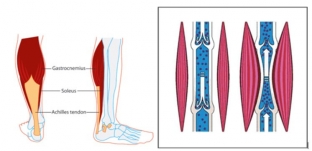
If the musculo-venous pump does not function properly, the heart cannot maintain normal blood pressure and/or supply blood to all body tissues. This may result in the following problems:
- swelling of the legs;
- varicose veins;
- pain in muscles and joints due to accumulation of excess fluid;
- fatigue;
- headaches;
- dizziness;
- blurred vision;
- cognitive dysfunction.
There are several ways to get rid of these symptoms. For example, with swelling, it is recommended to raise the legs above the level of the heart in order to drain excess fluid, wear compression stockings. There are also devices for electrical stimulation, which contribute to the contraction of the calf and soleus muscles and the outflow of fluid from the lower extremities. However, the best way is undoubtedly to train the soleus and calf muscles.
What exercises help strengthen the soleus and calf muscles?
Exercising the soleus and calf muscles will allow them to naturally support the musculo-venous pump. Below are exercises that will help to influence each of these muscles separately.
calf muscle (musculus gastrocnemius) – biceps, departs from the femur down and is attached to the Achilles tendon. It is the calf muscle that makes up the main visible mass of the lower leg.
Soleus muscle ( musculus soleus) – large and flat, descends from the tibia and fibula and attaches to the Achilles tendon, like the gastrocnemius, but the soleus muscle is flat and located under the gastrocnemius.
Simple soleus exercise:
The most effective exercises for strengthening the soleus muscle are exercises during which the legs are bent at the knees. Therefore, sit on a chair and place a thick book or other object that can serve as a platform under the ball of your foot. Raise your heels as high as possible, and then lower them below the level of the book. Repeat the exercise at least 25 times. To make the exercise more difficult, put a heavy object (such as a dumbbell) on your hips. A similar exercise can be performed on a special simulator in the gym.
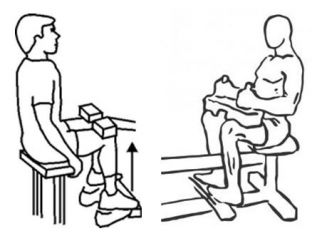
Soleus Stretching Exercise:
The figure below shows a stretch of the soleus muscle of the left leg. What you need to do: the foot located behind should “look” at in the direction of the wall, the heel should be on the floor, and both legs should be bent at the knees. In this case, the knee of the left leg, located behind, must be lowered without lifting the heel from the floor. When you feel that your heel is about to come off the floor, stay in this position for 10 seconds. Do 3 of these sets for each leg.
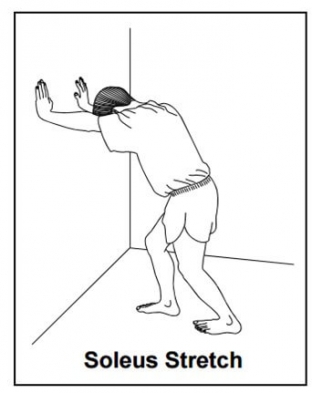
Easy calf exercise
To strengthen the calf muscle, you can perform a very simple exercise – toe lifts. Just in a standing position, begin to rise on your toes, keeping the body straight, without leaning forward or backward. Do 3 sets of 20 reps. Climbing stairs also helps strengthen the calf muscles, so it makes sense to abandon the elevator and start climbing the stairs on foot.
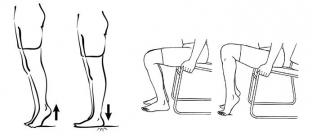
Exercise for stretching the calf muscle
The figure below shows a stretch of the calf muscle of the left leg. To perform the exercise, you must: lean against the wall and put the leg, with the muscle of which you need to work, behind the other leg. Make sure that the foot of the leg standing behind "looks" on the wall. Tighten the thigh muscles of the leg you are stretching, so & nbsp; so that the leg is as straight as possible at the knee. Now gradually lean against the wall, bending your elbows and keeping your heels on the floor. When you feel that your heel is about to come off the floor, stay in this position for 10 seconds without bending the leg you are stretching at the knee. Do 3 sets of 10 seconds each for the left and right legs.
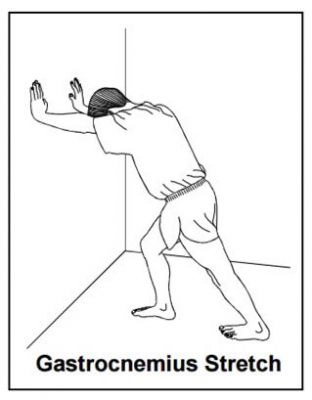
Read also: Leg stretching: beautiful legs at home
The soleus and gastrocnemius muscles play an important role in maintaining normal blood circulation, so they must be strengthened. We have tried to bring the simplest exercises that you can perform at home and we hope that they will benefit you.






Add a comment